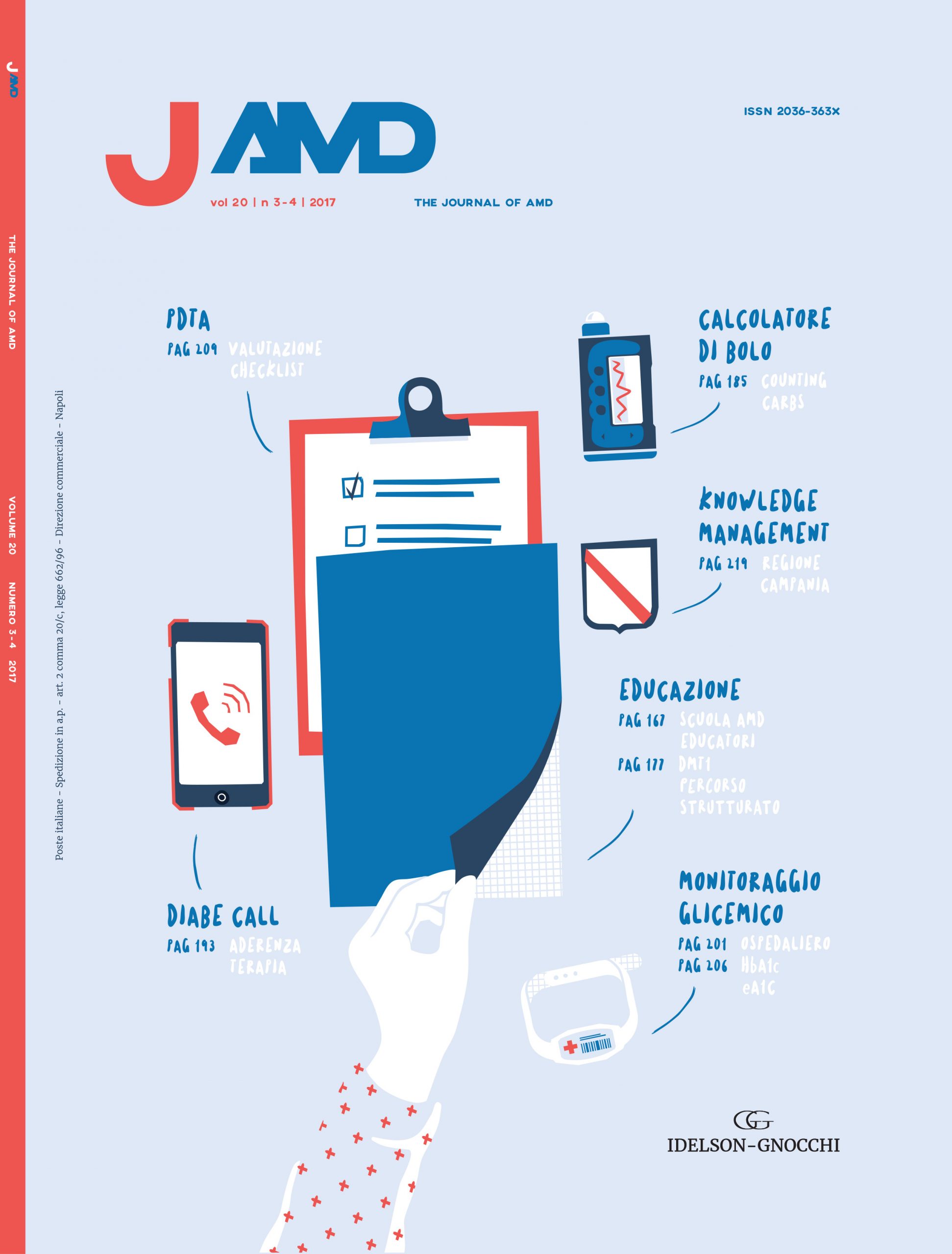Editorial
Between doubts and certainty
JAMD 2017;20(3-4):165-166
Don’t forget your future: today’s choice, tomorrow’s actions
JAMD 2017;20(3-4):167-176
The therapeutic approach to the diabetic patient has been completely revolutionized in the recent past by the introduction of a novel generation of drug classes, capable of ameliorating the gluco-metabolic control, but also to favor and protect the cardiovascular system.
While we are rapidly progressing through this exciting transition, our National Health Service is facing hard times, mainly attributable to this historic economy crisis. The Establishment has not been able to respond straightforwardly in order to ensure quality care and universal inclusivity, to address issues such as the ever-increasing expenses, poor or discontinuous assistance, to face global aging, lifestyle changes, the increased incidence of chronic diseases in spite of the new and improved medical treatments, especially when considering diabetology. On one hand we have been encouraged to adopt integrated clinical pathways bringing together diverse professional figures to maximize efficacy and effectiveness of the intervention, but on the other hand downsizings, corporate mergers and systematic linear resource cuts, were made.
Chronic stress may become an emotional nuisance for the employee who has to continuously work in this environment and deal with other people. It may interfere with the daily clinical activity of the diabetologist, and even trigger discomfort and burnout syndrome.
To actually change the system, we need to increase self-awareness among healthcare professionals. This, in turn, will increase the dedication to the Vision and the Mission, altogether restoring personal values and motivation, and building up the communication skills that will benefit the person/professional, the entire equip, the relationship with patients and care-givers, for an overall improvement of patient’s empowerment and engagement.
The AMD School for Educators has been conceived to forward these concepts, acknowledging that teaching methods have evolved towards new perspectives and behaviors. This is the key for establishing our individuality, originality, and professionalism. This is the way to achieve technical, social and managerial skills, but also a renewed professional dignity which is not granted by the position covered at work, but rather by the individual, who through the exercise of purpose and motivation may finally feel complete and content of his/her contribution.
KEYWORDS School for educators, AMD, Burnout, Self-awareness, Self-improvement.
Original articles
Taking care of a person with type 1 diabetes: patient training in the center of health care model for diabetes and metabolic diseases
JAMD 2017;20(3-4):177-184
Patient training is the key points of therapeutic strategy in patients with type 1 diabetes. It should start from the first access to the diabetic outpatient clinic. The Diabetes Care Unit of ASST Spedali Civili di Brescia created a different organizational model for taking care of type 1 diabetic patients, detailing step by step the education and training process, the aims and contents of the entire path and the roles of individual team work. Aim of the study was to evaluate, for one year our organizational model, identifying process, educational and psychological indicators. Most of them where compliant to the expected result. After evalueting the non compliant indicator we have reviewed the submit model to improve and make uniform the quality of care fore the patients with type 1 diabetes throughout the taking care in our Diabetes Care Unit.
KEYWORDS Type 1 diabetes mellitus, Educational therapy, Structured education programme, Engagement ed empowerment.
Use of bolo advisor together with carbo-counting: effects on glycemic control and quality of life
JAMD 2017;20(3-4):185-192
BACKGROUND The pre-prandial insulin requirement is proportional to the meal’s carbohydrate content (CHO). The CHO counting allows insulin-treated patients to determine the insulin dose at meal using the insulin / CHO ratio (the amount of carbohydrate in grams metabolized by 1UI of insulin). Technological innovation made available the bolus advisor a software (in insulin pump or glucometer) that can calculate and suggest the insulin dose by integrating the residual insulin, insulin/CHO ratio, insulin sensitivity, target glycemic, grams of CHO taken, patient’s state of health,intercurrent stress and physical activity.
PURPOSE The purpose of our study was to evaluate the impact of the use of the bolus advisor on the quality of life and the glycemic control of diabetic patients in intensive insulin therapy followed in Maggiore della Carità Hospital in Novara.
METHODS 56 consecutive patients with type 1 or type 2 diabetes in intensive insulin treatment with and without chronic complications of the disease using the bolus advisor were enrolled. During the planned outpatient visits, approximately 10 minutes of interviews were conducted using 3 questionnaires (PAID, DTSQ and Perceived Improvement in Diabetes Management-Related Factors) and social and schooling level has been evaluated. Some clinical data (HbA1c, BMI and lipid profile) were also collected.
RESULTS The questionnaire analysis revealed that, despite concerns about acute and chronic complications of diabetes, most patients are satisfied with the therapy and relationship with the diabetic team. In relation to the bolus advisor, there was a favorable impact on the fear of hypoglycemia, on the calculation of insulin dose, on self-management of the disease, and on general well-being. There was also a statistically significant reduction in glycated hemoglobin, independent of the duration of use of the bolus advisor.
CONCLUSIONS Our work documented the positive impact of bolus advisor on lifestyle quality and glycemic control suggesting that it could represent, since the onset of the disease, an effective tool for better management and self-management of diabetes.
KEYWORDS Carbo-counting, Therapeutic education, Self management, Flexibility and Quality of life.
DIABE.CALL (DiabetologistsCall) to improve the adherence to therapy in people with diabetes mellitus
JAMD 2017;20(3-4):193-200
The treatment of a chronic disease such as Diabetes Mellitus type 2 involves the persistent change of lifestyle, an appropriate self-monitoring program, and, in most cases, a continuous assumption of a pharmacological therapy. Unfortunately, in the clinical setting, an poor adhesion to pharmacological therapy is reported in 38%- 93% of patients. Education programs to diabetes self-management have been shown to be effective, but they usually have a limited accessibility. In absence of these structured programs, health care providers should rely on other educational resources. To implement a continuous control over time, several tools have been proposed, including remote monitoring. Therefore, the aim of this study was to assess whether telephone counseling activities would improve metabolic control in a population of persons with diabetes. Four hundred and eighty patients have been recruited in 11 diabetes centers in the region Campania (ITALY). Study participants have been divided in random way in two groups: the patients of the group A (240 patients) received regular telephone calls every 20 days for at least three times between the visits, for a total of nine contacts with in seven-nine months, whereas the control group (group B, n=240 patients) received standard care. The phone calls were conducted through a structured interview. The effectiveness of this interactive mode between diabetes team and person with diabetes (PwD) has been verified in terms of improvement of metabolic control (fasting blood glucose, HbA1c) and major cardiovascular risk factors (BMI, blood pressure, cholesterol and triglycerides serum levels). At the end of the study, HbA1c values improved significantly more in the Group A as compared to the Group B (1. 44% vs. 0.64%; p = 0.003). The multivariate regression analysis showed that the change in HbA1c was significantly associated to counseling intervention, independently of other confounding factors such as age, starting insulin therapy, BMI and duration of diabetes. Other parameters such as systolic and diastolic blood pressure, serum cholesterol and triglycerides levels also improved in both groups although not significantly.
CONCLUSIONS Our data show that telephone counseling could be useful to improve the metabolic control in people with diabetes, probably augmenting the adherence to drug therapy.
KEYWORDS Adherence to therapy, Diabetes, Remote monitoring.
In-hospital glucose monitoring: adequacy and resource management
JAMD 2017;20(3-4):201-205
Capillary blood glucose monitoring in the hospital population is crucial, as glycemic impairment is associated with a high morbidity and mortality. In our experience the monitoring practice appeared to be inappropriate with the real needs, and it is not related to immediate intervention leading to a modification in patients care. Therefore we analyzed the number of glycemic determinations extracted from the electronic medical records (EMR) (excluding intensive care units) of all the hospitalized subjects during the first six months of 2015. We then finalized a protocol for glucose monitoring, shared with all the hospital medical and nursing staff, based on different patients clinical conditions, with the aim to optimize the use of resources and to make these measurements uniform and significant. A systematic and more aware use of capillary blood glucose monitoring as a decision supporting tool, eventually in conjunction with an “alert” mechanism, can be a valid support to improve in-patients cares.
KEYWORDS Glucose monitoring, Hospitalization, Resources management.
Punto di vista
«Your glycemic control is optimal... on average»: HbA1c pitfalls in glucose monitoring of patients with diabetes
JAMD 2017;20(3-4):206-208
Attività dei gruppi AMD
A check list for assessing appropriateness of Integrated Management Pathways (PDTA) for Diabetes
JAMD 2017;20(3-4):209-218
Diabetes is becoming a worldwide pandemic with enormous economic and social costs for any country. Therefore, it is important, to face more effectively this emergency by relying on a healthcare organization that, in addition to making good use of the resources, allows patient access to care. It’s from this assumption that PDTA has developed; in it, a multidisciplinary team provides the patient, who is being placed at the center of system, all the tools required to manage his pathology. Objective of the study is to create a check-list that tests the appropriateness of existing PDTAs or guide specialists to creating new ones.
MATERIALS AND METHODS Collection of italian national and regional legislation on PDTAs; extraction of common and/or innovative aspects and search for evidence in literature. Aim is to create a check-list with basic points that a PDTA must contain in order to be appropriate, and 4 optional points, respectively with different weight, that a PDTA must contain to be “Appropriate and Good” or “Appropriate and Excellent”.
RESULTS 9 basic points, each score 10 and 4 optional points with increasing weight. PDTA to say must have scored 90 in the basic points; if the sum with the optional points score is ≤97 the PDTA is considered as “Appropriate and Good”, if score is >97 the PDTA is considered as “Appropriate and Excellent”.
CONCLUSIONS Since diabetic patients are often affected by two or more disabling chronic diseases perhaps specialist should start thinking about PDTA not for individual pathology, but instead PDTA for care complexity.
KEYWORDS Type 2 diabetes mellitus, Integrated Management, PDTA, Appropriateness.
Attività delle Sezioni regionali
Laws knowledge improves diabetes clinical pathway. Knowledge manage¬ment and business process reengineering
JAMD 2017;20(3-4):219-226
Diabetes mellitus is a rapidly increasing non transmissible disease with high social and economic impact and costs. The Italian strategy against diabetes has far-reaching roots, i.e. the National Diabetes Law, which, in 1987, introduced an innovative care model characterized by patient centrality through the establishment of Territorial Diabetes Centers. The Law 115/87 has been followed by many other subsequent laws which assure a good management of diabetes, even with respect to the different economic and social changes occurred in the last decades.
Our health care system is characterized by normative sources practically developed in chronic care models pathways. Our region, Campania, boasts a variety of standards in the field of diabetes. The analysis of laws is an in-depth analysis necessary to define the welfare care processes, allowing them to be improved, when necessary, and coordinating and aligning them to the underlying scientific knowledge (Good Quality Clinical Practice, Evidence Based Medicine).
The aim of AMD Campania’s “Law and Institution” working group is to promote an active role of the diabetes specialist in the care pathway organization for the person with diabetes through the acquisition of a specific knowledge of the laws governing diabetes care (knowledge management). For this purpose, we have drafted a VADEMECUM of national and regional laws, as a tool for an easy and quick consultation, focusing our attention on the week points of Laws and their level of accomplishment in the territory. As a further step, a web survey will be carried out as a monitoring tool to detect the level of knowledge of the regulations by diabetologists operating in Campania Region.
KEYWORDS Diabetes, Diabetic Care, Knowledge management, Role of diabetes specialist.
Attività delle Sezioni regionali
XXIII Congresso regionale AMD-SID Lombardia
XXIII AMD-SID Regional Congress Lombardia Coccaglio (BS), 6-7 ottobre 2017
JAMD 2017;20(3-4):227-42
Le news di AMD
Newsletter Annali AMD n. 20
AMD Annals Newsletter n. 20
JAMD 2017;20(3-4):243-4
Newsletter Rete di Ricerca n. 36
AMD Research Network Newsletter AMD n. 36
JAMD 2017;20(3-4):245-6
Gruppo Medicina di genere
Gender Medicine Workgroup
JAMD 2017;20(3-4):247-50




